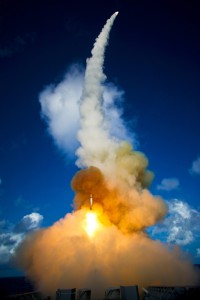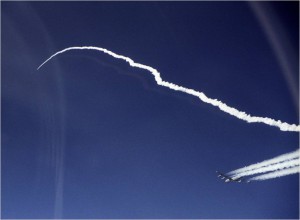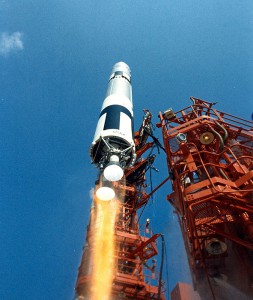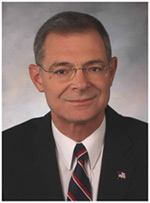Make Your Career Soar
Make Your Career Soar
White Eagle Aerospace offers expert, personalized engineering consulting services to assist your organization in its challenging technical projects. As a widely experienced professional aerospace engineer with over 50 years of experience, our President and CEO J. Terry White is available to consult within the following aeroscience disciplines:
Throughout his 50-year aerospace engineering career, Terry has served in a variety of technical and leadership capacities for the following organizations:
A few of the projects Terry has been involved with during his extensive career as an aerospace engineer include:

Objective: Development and testing of a multi-stage, hypersonic, hit-to-kill missile designed to intercept an exoatmospheric target
Summary: This was a multiple task effort consisting of (1) 6-DOF aerodynamics model generation, (2) payload compartmental venting system development, (3) debris dispersion footprint estimation, and (4) flight test performance validation. The 6-DOF aero model required consideration of nine (9) distinct vehicle configurations that accrued between launch and target intercept. Development of the compartmental venting system was required due to outgassing of the missile payload within a confined internal volume. Parametric analysis of the time-variant venting process resulted in specification of the number, external location, and type of vent devices. Predicted venting performance agreed closely with flight test venting measurements. Multiple flight tests of the hypersonic interceptor were conducted with all missile debris falling within the 3Σ dispersion footprint. Flight extracted aerodynamic forces and moments agreed well with predictions based on the 6-DOF aerodynamics model.
 Missile IR Seeker Cover Jettison
Missile IR Seeker Cover JettisonObjective: Establish the safe separation envelope for an aerodynamic cover protecting a missile side-mounted IR seeker in supersonic flight
Summary: A multiple degree-of-freedom jettison simulation was developed and employed to conduct safe separation studies of the subject cover. The aerodynamics model for the wedge-shaped device was generated using engineering methods while the missile shock layer flowfield model was generated using Euler-based computational fluid dynamics. A comprehensive Monte Carlo analysis that considered 3Σ uncertainties in aerodynamics, flowfield properties, cover release actuator output, cover release conditions, and atmospheric properties provided the required safe separation envelope as functions of Mach number, altitude, and missile total angle-of-attack and aerodynamic roll position. Cover separation time histories generated by the jettison simulation matched very well with those experimentally-determined in the wind tunnel as well as full-scale sled track testing.
 Hypersonic Aircraft Flush Airdata Sensing System
Hypersonic Aircraft Flush Airdata Sensing SystemObjective: Design, develop, and test a Flush Airdata System (FADS) for the HYPER-X Research Vehicle (HXRV) also known as the X-43A
Summary: A 9-port FADS layout was devised to provide inflight airdata consisting of Mach number, dynamic pressure, angle-of-attack, angle-of-sideslip at hypersonic speeds. Implementation included use of a suite of precision pressure transducers connected to individual pressure orifices via small-diameter, long-flow-path pneumatic tubing. The combination of long internal flow paths and the low ambient pressures associated with high altitude flight required compensation for the effects of pneumatic lag, internal flow wave-induced spectral distortion, and internal flow thermal transpiration on the sensed pressure signal. Ground testing using a 80%-scale forebody model and full-scale pressure transducers and plumbing was conducted at Mach numbers between 2 and 8. The X-43A FADS system was successfully flown and operated at flight Mach numbers up to 10.
 Access To Space
Access To SpaceObjective: Perform a conceptual design and analysis of launch vehicle and reentry vehicle systems intended for manned commercial access to space
Summary: Major tasks included multi-stage launch vehicle configuration synthesis, aerodynamics model generation, and optimization of the ascent trajectory into orbit. The spacecraft attitude control system was sized to provide 3-axis flight control both on-orbit and during reentry. Continuum and rarefied flow aerodynamic models were generated and implemented in performing flight simulations of the reentry vehicle trajectory following activation of the deorbit propulsion system. A major aspect of the work involved minimizing the reentry vehicle thermal protection system mass and yet select a material that allowed the heatshield to be reused over multiple missions.
 Missile Debris Dispersion Footprint
Missile Debris Dispersion FootprintObjective: Devise, develop, and validate an analytically-based system for estimating the 3Σ dispersion footprint for debris elements resulting from in-flight destruction of a missile airframe
Summary: A debris dispersion footprint was required as part of the process to gain range safety approval for flight at major missile test installations. Missile debris included randomly tumbling, low and high ballistic coefficient elements resulting from activation of the flight termination system via either a command destruct or self-destruct. Key work focused on (1) defining the types of debris that result from missile detonation, (2) formulation of creditable missile failure scenarios, (3) development of representative ballistic coefficient models for various types of missile debris, and (4) development of a multiple degree-of-freedom flight simulation. Upon completion, the overall debris dispersion footprint estimation system was validated using previous flight test results and subsequently became a key component of obtaining safety approval for the conduct of numerous missile flight tests over a period of 15 years.
 Hypersonic Airbreathing Vehicle Flight Test
Hypersonic Airbreathing Vehicle Flight TestObjective: Obtain aerodynamic flight research measurements during hypersonic flight of the X-43A airframe-integrated scramjet test vehicle
Summary: This was a multiple task effort requiring (1) layout of a flight test instrumentation system, (2) acquiring surface pressure and temperature data , and (3) extraction of vehicle aerodynamic forces and moments from flight motions. A suite of pressure orifices and thermocouples was devised for making local aerodynamic measurements at over 300 locations on the vehicle surface. The type, range, sensitivity, and data acquisition rate were specified for each of these sensors. The development and installation of the instrumentation system was controlled via a rigorous configuration management system. The flight research measurements obtained from hypersonic flights of the X-4A to Mach 7 and Mach 10 were of unprecedented quantity and quality. Using a combination of the Best Estimated Trajectory (BET), Inertial Navigation System (INS) accelerometer and rate gyro measurements, control surface deflection-time histories, 3-space mass properties, and the Body Axis 6-DOF equations of motion, the vehicle 6-DOF aerodynamic forces and moments were successfully extracted throughout the descent flight profile of each mission.

J. Terry White is the founder, senior advisor and former president of White Eagle Aerospace. His 50 years of professional aerospace experience includes the NASA Space Shuttle Program, NASA X-43A Flight Research Project, and the United States Navy STANDARD Missile Program. During his far-ranging professional career, Terry has served on the engineering technical staff of Rockwell International, General Dynamics Corporation, Hughes Missile Systems Company, NASA Dryden Flight Research Center and Raytheon Missile Systems. In addition, he has served as an engineering consultant to numerous corporate and private aerospace enterprises.
Terry is a subject matter technical expert in the disciplines of aerodynamics, 6-DOF aerodynamics models, aerothermodynamics, hypersonics, flight simulation, and flight testing.
Terry previously served as manager of the Aerodynamics Department in the Guidance, Navigation, and Control Center at Raytheon Missile Systems in Tucson, Arizona. In this capacity, he was responsible for all aerodynamics work performed at the world’s largest tactical missile producer. He concluded his career with Raytheon in 2010 as a Senior Engineering Fellow in Aerodynamics.
Terry has authored more than 180 technical papers on a wide variety of aero-science and aerospace subjects. His teaching credentials include 15 years as an instructor in the Aerospace Engineering Department of the California State Polytechnic University, Pomona, 10 years as an instructor in the professional development program at Raytheon and 17 years developing and teaching technical courses at White Eagle Aerospace. Those who have taken Terry’s courses say that he brings an extensive technical knowledge and uncommon instructional skill to the training environment.
Terry is particularly well-known for his inspiring aerospace history presentations, which are intense, technically relevant reviews of significant events in United States aerospace history. He has lectured extensively on aerospace history topics at the USAF Test Pilot School, the Society of Experimental Test Pilots, the National Aeronautics and Space Administration, the American Institute of Aeronautics and Astronautics, academia and industry.
Terry and his wife Phyllis reside in Oro Valley, Arizona. They are the happy parents of five remarkable children and the grateful grandparents of nine delightful grandchildren.